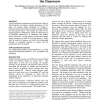Free Online Productivity Tools
i2Speak
i2Symbol
i2OCR
iTex2Img
iWeb2Print
iWeb2Shot
i2Type
iPdf2Split
iPdf2Merge
i2Bopomofo
i2Arabic
i2Style
i2Image
i2PDF
iLatex2Rtf
Sci2ools
ACMIDC
2008
2008
Embodying scientific concepts in the physical space of the classroom
Several simulation environments exist that create a place in which students can explore scientific phenomena. In this paper, we propose design guidelines for creating a classroom environment that puts scientific concepts directly into that physical space. We examine the results of two implementations of WallCology, which we characterize as an embedded phenomenon, in elementary and middleschool classrooms. Several instances of innovative student inquiry emerged as a result of the design features. Along with the results of learning, we look at the relationship between an embodied approach to design and the imaginative role of the student. ACM Classification Keywords H.5.3 [Information interfaces and presentations (e.g., HCI)] Group and Organization Interfaces. K3.1 [Computers and Education]
ACMIDC 2008 | Human Computer Interaction | Innovative Student Inquiry | Several Instances | Several Simulation Environments |
| Added | 12 Oct 2010 |
| Updated | 12 Oct 2010 |
| Type | Conference |
| Year | 2008 |
| Where | ACMIDC |
| Authors | Peter Malcolm, Tom Moher, Darshan Bhatt, Brian Uphoff, Brenda López Silva |
Comments (0)

